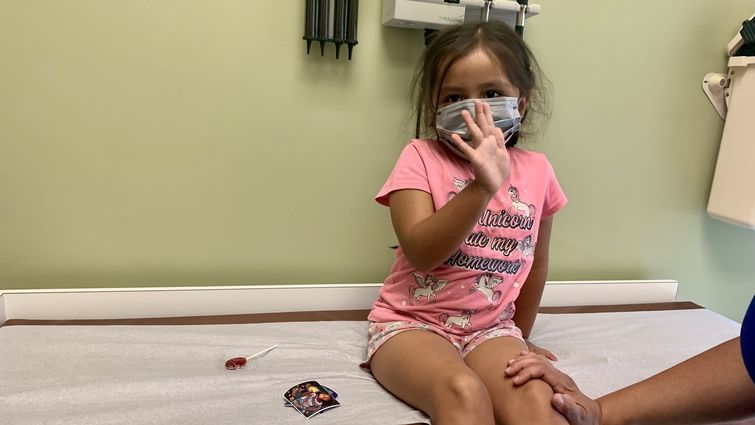
Three-year-old Abby was one of the first patients at Loma Linda University Children's Hospital to receive a COVID-19 vaccination in the 6 month-4 year age group.
New COVID-19 variants continue to emerge and cycle around the country. For quick answers and peace-of-mind, it’s important for parents to feel comfortable and prepared to use at-home tests on themselves and their kids when the need arises.
Alexandra Clark, MD, division chief of general pediatrics and pediatric hospital medicine at Loma Linda University Children’s Health, walks parents through some of the basics.
Antigen versus PCR tests
Majority of at-home COVID-19 tests are antigen tests, meaning they test for small virus proteins in the body and provide rapid results in approximately 15 minutes.
These tests differ from PCR — polymerase chain reaction tests, which can be done at the doctor’s office, drugstore, or testing center. While PCR tests can be taken at home, the results must be run through a lab, taking 24 to 48 hours. PCR tests look for genetic material from the virus and can stay positive long after a patient is no longer infectious.
Clark encourages every household to have at-home tests available. Free versions are available from the Centers for Disease Control and Prevention website, and many health insurances cover free tests as well. To ensure the validity of their at-home tests, parents should not buy tests from a third-party person or online vendor but rather a pharmacy or retail store.
When should I use an at-home test for my child?
Rapid at-home tests are useful and convenient when your child starts exhibiting or feeling COVID-19 symptoms or they’ve had a known exposure to someone who’s sick.
“Rapid antigen tests are a really good way to rule-in disease,” Clark says. “If the results are positive for COVID-19, there’s a very low risk of a false positive test result. But on the flip side, an antigen test is not a perfect test to rule out disease because it’s not quite as sensitive as a PCR test. So, it’s possible to have a false negative, you’re just not swabbing a large enough sample, or there’s not enough detectable virus yet.”
If the first test is negative while your child is still showing symptoms, Clark says its best to quarantine your child that same day and retest the next day.
Can at-home tests be used on any age child?
While at-home tests may be used on kids who are very young, Clark cautions parents to be extra careful, especially if they decide to test their infant or toddler. “There’s the chance they won’t hold still while you swab their nose and you don’t want to cause trauma,” she says.
She suggests a team of two assist in giving the test, whether it’s two parents or a parent and caregiver, allowing one to safely hold the child, while the other ensures the swab sample is taken properly.
“You also need to be careful because most swabs that come with antigen test kits are not necessarily the size of an infant or toddler’s nose,” Clark says. “But is it valid to test them even though they’re young? Yes.”
What is the next step after a positive at-home test?
If your child tests positive on an at-home antigen test and is showing symptoms — fever, cough, fatigue, body aches, etc. — follow quarantine guidelines for that child and any family members exposed to them.
For parents caring for children who test positive, it’s best they are up-to-date on vaccines and boosters, wear a mask, wash their hands frequently, and ensure they’re cleaning the household surfaces frequently.
The CDC’s current recommended isolation period is five days if symptoms resolve and there’s no fever. Then followed by five days of masking around others.
“For infants and toddlers who can’t mask, it would be 10 days after the child has tested positive or had their first symptom,” Clark says.
New layers of protection for children
With the newest COVID-19 vaccine authorization for kids ages six months to four years old, Clark says we now have an additional tool for 17 million vulnerable patients to protect them from getting the disease. While this protection is not necessarily a hundred percent protectant, it has shown a significant decrease in the risk of serious disease and death in kids and adults.
“We’re trying to encourage families who have children in this age group to vaccinate them, unless there’s a true medical reason indicated by their pediatrician or sub-specialist that would not qualify them,” she says. “I know that families are worried about things that are new. But families should be worried about infection. The children we’re treating who are having long-COVID symptoms, the children who have been hospitalized, and, sadly, the children that we’ve lost across the nation as a result of COVID-19 are victims of this disease.”
Clark encourages parents to partner with their trusted primary care provider and have an honest conversation about their concerns.
To schedule your child’s COVID-19 vaccine at Loma Linda University Children’s Hospital’s pediatric department, call us at 909-558-2828.
